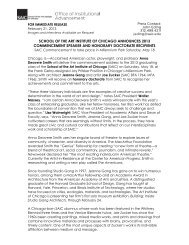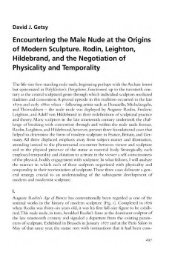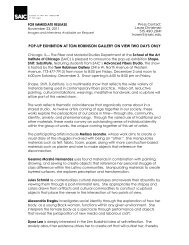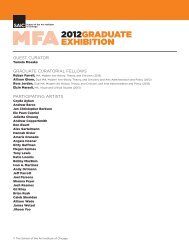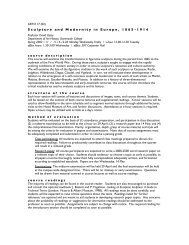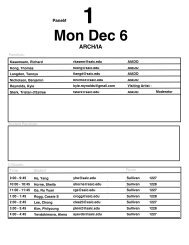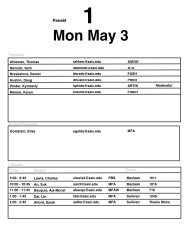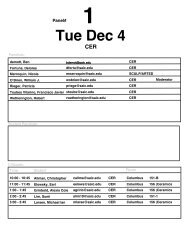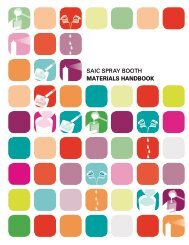i. institutional support and commitment to continuous improvement
i. institutional support and commitment to continuous improvement
i. institutional support and commitment to continuous improvement
You also want an ePaper? Increase the reach of your titles
YUMPU automatically turns print PDFs into web optimized ePapers that Google loves.
Course Number & Title:<br />
INARC 5110 Interior Architecture Studio 1:<br />
Emotive Space (4.5)<br />
Course Description:<br />
This introduc<strong>to</strong>ry studio addresses site as a genera<strong>to</strong>r<br />
of architectural ideas <strong>and</strong> examines how architecture<br />
constructs, <strong>and</strong> responds <strong>to</strong>, site conditions. It pays close<br />
attention <strong>to</strong> issues of site that affect the development of<br />
interior space. Additionally, students examine inherent<br />
material effects, <strong>and</strong> more ephemeral sensory effects,<br />
<strong>and</strong> their manipulation <strong>to</strong> communicate an architectural<br />
intention in a single space. Architectural “transitions” in-<br />
cluding approach, entry, occupation <strong>and</strong> egress are stud-<br />
ied in order <strong>to</strong> posit the building as a sustainable system<br />
<strong>and</strong> the threshold between interior <strong>and</strong> exterior space.<br />
Course Goals & Objectives:<br />
1) Design culture: introduction <strong>to</strong> the role of site<br />
<strong>and</strong> material context in contemporary architectural<br />
design.<br />
2) Design practice: introduction <strong>to</strong> basic design<br />
methods, emphasizing conceptual experimentation<br />
<strong>and</strong> rigor, material innovation, <strong>and</strong> cultural invention<br />
through the conceptual design of a small building<br />
with an extensive site infrastructure.<br />
3) Design techniques <strong>and</strong> skills: develop an inter-<br />
mediate level of architectural representation, with<br />
an emphasis on visual explanation <strong>and</strong> analysis,<br />
plans, sections <strong>and</strong> elevations, <strong>and</strong> basic manual<br />
model construction.<br />
Student Performance Criterion:<br />
1) Best exemplifies the following criteria:<br />
a) A.6. Fundamental design skills (ability)<br />
b) B.4. Site Design (ability)<br />
2) Additional criteria<br />
a) A.2. Design thinking (ability)<br />
b) A.5. Investigative Skills (ability)<br />
c) A.8. Ordering Systems Skills (underst<strong>and</strong>ing)<br />
d) A.10. Cultural Diversity (ability)<br />
Topical Outline:<br />
1) Design culture: students will investigate the rela-<br />
tionship of site <strong>to</strong> interior space <strong>to</strong> site as developed<br />
in contemporary art <strong>and</strong> architecture, completing<br />
case studies that relate the use of site in contem-<br />
porary art practice <strong>to</strong> contemporary architectural<br />
design; 15% of the course.<br />
2) Design culture: through a series of readings of<br />
contemporary theory related <strong>to</strong> site, students will<br />
develop a written statement describing the relation-<br />
ship of their project <strong>to</strong> contemporary architectural<br />
design practice; 10% of the course.<br />
165 | Spring 2011<br />
IV. Supplemental Information<br />
3) Design practice: through a series of lectures <strong>and</strong><br />
demonstrations, students will be introduced <strong>to</strong> site<br />
documentation <strong>and</strong> analysis techniques; students<br />
will prepare a series of diagrams <strong>and</strong> explana-<br />
<strong>to</strong>ry graphics describing both the qualitative <strong>and</strong><br />
quantitative characteristics of the existing site <strong>and</strong><br />
proposed site design; 10% of the course.<br />
4) Design practice: working from ideas generated<br />
through the case studies <strong>and</strong> site analysis, students<br />
will develop a design for a building <strong>and</strong> site that in-<br />
tegrates site considerations with architectural ideas;<br />
students will work through an iterative process that<br />
integrates analog <strong>and</strong> digital techniques, <strong>and</strong> will<br />
make formal presentations at 50%, 75% <strong>and</strong> 100%<br />
completion, at an introduc<strong>to</strong>ry level of accomplish-<br />
ment; 25% of the course.<br />
5) Design techniques: students will document their<br />
conceptual design through a complete <strong>and</strong> coordi-<br />
nated set of site plans <strong>and</strong> sections, <strong>and</strong> building plans,<br />
sections, elevations, showing context, scale figures <strong>and</strong><br />
materials, using CAD, <strong>and</strong> showing appropriate line<br />
types, weights <strong>and</strong> notations at a professional level;<br />
15% of the course.<br />
6) Design techniques: students will document their<br />
conceptual design through physical site <strong>and</strong> build-<br />
ing models, emphasizing material effects <strong>and</strong> formal<br />
ideas, at a professional level; 15% of the course.<br />
7) Design techniques: students will complete ap-<br />
proximately 10’x10’ <strong>to</strong>tal of presentation boards,<br />
showing all plans, sections <strong>and</strong> elevation context,<br />
scale figures <strong>and</strong> materials, along with <strong>support</strong>ing<br />
analysis <strong>and</strong> information, that may include vignettes<br />
<strong>and</strong> models, at a professional level; 10% of the<br />
course.<br />
Prerequisites:<br />
5004, 5005, 5006<br />
Textbooks/Learning Resources:<br />
Various sources including:<br />
• Interior Atmoshperes Bridging the Thresh-<br />
olds of Interior <strong>and</strong> L<strong>and</strong>scapes, An interview with<br />
Petra Blaisse<br />
Offered (semester <strong>and</strong> year):<br />
• Semester: FALL<br />
• Year: ONE<br />
Faculty assigned:<br />
• 2009-2010 academic year:<br />
Miller, Carl Ray (F/T)<br />
• 2010-2011 academic year:<br />
Miller, Carl Ray (F/T), Kasemsarn, Richard<br />
(P/T)<br />
Supplemental Information<br />
SECTION IV



